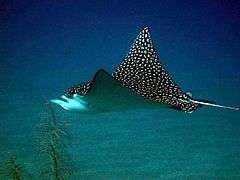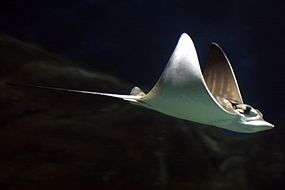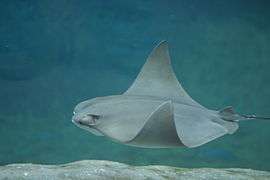Eagle ray
| Eagle ray Temporal range: 100.5–0 Ma Late Cretaceous to Recent[1] | |
|---|---|
| | |
| Spotted eagle ray, Aetobatus narinari | |
| Scientific classification | |
| Kingdom: | Animalia |
| Phylum: | Chordata |
| Class: | Chondrichthyes |
| Order: | Myliobatiformes |
| Family: | Myliobatidae Bonaparte, 1838 |
The eagle rays are a group of cartilaginous fishes in the family Myliobatidae, consisting mostly of large species living in the open ocean rather than on the sea bottom.
Eagle rays feed on mollusks and crustaceans, crushing their shells with their flattened teeth. Devil and manta rays filter plankton from the water. They are excellent swimmers and are able to breach the water up to several metres above the surface. Compared with other rays, they have long tails, and well-defined rhomboidal bodies. They are ovoviviparous, giving birth to up to six young at a time. They range from 0.48 to 9.1 m (1.6 to 29.9 ft) in length.[1]
Classification
Nelson's 2006 Fishes of the World (4th edition), as well as FishBase, recognizes seven genera in three subfamilies. Some systematists, such as William Toby White, raise the subfamilies to family level instead, placing the cownose rays in Rhinopteridae, and the manta and mobulas in Mobulidae.[2] Under this arrangement, three genera (Aetobatus, Aetomylaeus and Myliobatis) remain in Myliobatidae, while a fourth (Pteromylaeus) is considered synomous with Aetomylaeus.[2]
Subfamily Myliobatinae
Aetobatus
The spotted eagle ray, A. narinari, also known as the bonnet ray or maylan, belongs to this genus. The ray bears numerous white spots on its inky blue body. It has a span width of 2.5 m (8.2 ft) and a maximum reported weight of 230 kg (510 lb).[3] Including the tail, it can reach up to 5 m (16 ft) in length. The spotted eagle ray is found in the tropical areas of all oceans, including the Caribbean Sea and the Gulf of Mexico. The genus also includes the much smaller longheaded eagle ray, A. flagellum, which is a widespread but uncommon species of Indian Ocean and western Pacific coasts. This is considered an endangered species due to huge pressure from fisheries throughout its range.[4]
Aetomylaeus
This obscure genus is distributed in the Indian Ocean and the Western Pacific. These rays were named because they lack a sting on the tail. If Pteromylaeus is considered synomous (as suggested by genetic evidence) with Aetomylaeus, the latter is also found in the East Pacific and the Atlantic.[2]
Myliobatis
The common eagle ray, M. aquila, is distributed throughout the Eastern Atlantic, including the Mediterranean Sea and the North Sea. Another important species is the bat eagle ray, M. californica, in the Pacific Ocean. These rays can grow extremely large, up to 1.8 m (6 ft) including the tail. The tail looks like a whip and may be as long as the body. It is armed with a sting. Eagle rays live close to the coast in depths of 1 to 30 m (3 to 98 ft) and in exceptional cases they are found as deep as 300 m (980 ft). The eagle ray is most commonly seen cruising along sandy beaches in very shallow waters, its two wings sometimes breaking the surface and giving the impression of two sharks traveling together.
Pteromylaeus
- For other species that go under the same name, see Bull ray (disambiguation).
The bull ray, P. bovinus, is also named for the shape of its head. It is a very large ray, often 180 cm and sometimes up to 2.3 m (7.5 ft) in length. This ray can be found along Atlantic coasts between Portugal and South Africa. It is also distributed throughout the Mediterranean Sea. Another species in this genus, the rough eagle ray, P. asperrimus, is just 80 cm (2.6 ft) in length and lives around the Galapagos islands. Based on genetic evidence, some recent authorities have treated Pteromylaeus as a synonym of Aetomylaeus,[2] but FishBase continues to recognize the two as separate.[5]
Subfamily Rhinopterinae
Rhinoptera
Cownose rays are named for their ungainly, odd-looking heads. Apart from that, they look very much like the above genus. Their whip-like tails are armed with one or more stings. Species include the Javanese cownose ray, R. javanica, in the Indian Ocean and the western Pacific, the Australian cownose ray, R. neglecta, around the Australian coasts, and the Atlantic cownose ray, R. bonasus, in the western Atlantic and the Caribbean.
Subfamily Mobulinae
†Archaeomanta
Main article: Archaeomanta
An extinct group of mobulid that lived from the Cretaceous to the Eocene.
Manta
The manta rays are the largest members of the ray family, ranging up to 6.7 m (22 ft) from wing tip to wing tip and weighing up to 1,350 kg (2,980 lb). They inhabit the tropical seas of the world and are often observed around coral reefs.
Mobula
The mobulas are similar in appearance to manta rays, but differ in having subterminal rather than terminal mouths.
See also
References
- 1 2 Froese, Rainer, and Daniel Pauly, eds. (2015). "Mylobatidae" in FishBase. April 2015 version.
- 1 2 3 4 White, W.T. (2014): A revised generic arrangement for the eagle ray family Myliobatidae, with definitions for the valid genera. Zootaxa, 3860 (2): 149–166.
- ↑ Florida Museum of Natural History Ichthyology Department
- ↑ World Conservation Union "Red List" of threatened species
- ↑ Froese, Rainer, and Daniel Pauly, eds. (2015). Species of Pteromylaeus in FishBase. September 2015 version.





